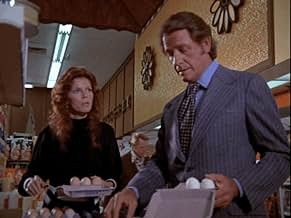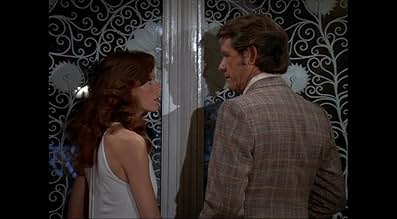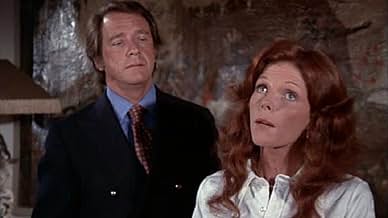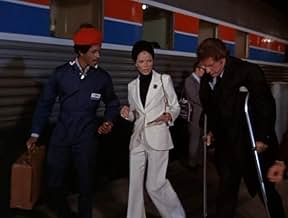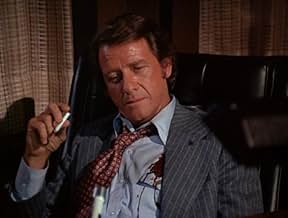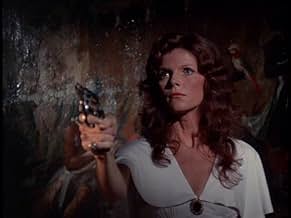IMDb RATING
4.6/10
641
YOUR RATING
A scheming wife lures an insurance investigator into helping murder her husband and then declare it an accident. The investigator's boss, not knowing his man is involved in it, suspects murd... Read allA scheming wife lures an insurance investigator into helping murder her husband and then declare it an accident. The investigator's boss, not knowing his man is involved in it, suspects murder and sets out to prove it.A scheming wife lures an insurance investigator into helping murder her husband and then declare it an accident. The investigator's boss, not knowing his man is involved in it, suspects murder and sets out to prove it.
Arnold F. Turner
- Redcap
- (as Arnold Turner)
Rand Brooks
- Conductor
- (uncredited)
Tom Curtis
- Charlie
- (uncredited)
John Furlong
- George
- (uncredited)
Featured reviews
Watch the Original with the same title from 1944! This made for TV movie, is just god-awful! Although it does use (as far as I can tell) almost the same dialog, it just doesn't work! Is it the acting, the poor directing? OK so it's made for TV, but why watch a bad copy, when you can get your hands on the superb original? Especially as you'll be spoiled to the plot and won't enjoy the original as much, as if you've watched it first!
There are a few things that are different from the original (it's shorter for once), but all are for the worse! The actors playing the parts here, just don't fit the bill! You just don't believe them and who could top Edward G. Robinsons performance from the original? If you want, only watch it after you've seen the original and even then you'll be very brave, if you watch it through! It's almost sacrilege!
There are a few things that are different from the original (it's shorter for once), but all are for the worse! The actors playing the parts here, just don't fit the bill! You just don't believe them and who could top Edward G. Robinsons performance from the original? If you want, only watch it after you've seen the original and even then you'll be very brave, if you watch it through! It's almost sacrilege!
This remake of the film noir classic about a seductress and an insurance man having an affair of horror, planning the murder of her husband, gives us the same question as just about any remake.
Why the remake? Many remakes are simply film adaptations of classic novels, such as TREASURE ISLAND.
Here, though, we have what is essentially a "homage" to E.G. Robinson and the others, who made the original classic.
The crux of the story is the Columbo style E.G. character. He is always the important one. And Lee J Cobb does a fine job. In fact, he is the the entire show in this one. I don't mean to disparage Richard and Samantha, but they were very bland.
And that was probably the point, to keep them bland.
It still makes for the question "Why the remake?" Lee J Cobb tries to make this his own role. And that's okay. You really don't want to try to mimic a classic. He does okay, but there are times when E.G. just did it perfect. For example, when he says "Closer than that", E.G. was perfect. Cobb, in the effort to make it his own, knows it is taking something away when he adds "much closer", but he doesn't want to be compared too much to E.G.'s perfect portrayal.
Which is why you don't really want to remake a classic film noir.
Why the remake? Many remakes are simply film adaptations of classic novels, such as TREASURE ISLAND.
Here, though, we have what is essentially a "homage" to E.G. Robinson and the others, who made the original classic.
The crux of the story is the Columbo style E.G. character. He is always the important one. And Lee J Cobb does a fine job. In fact, he is the the entire show in this one. I don't mean to disparage Richard and Samantha, but they were very bland.
And that was probably the point, to keep them bland.
It still makes for the question "Why the remake?" Lee J Cobb tries to make this his own role. And that's okay. You really don't want to try to mimic a classic. He does okay, but there are times when E.G. just did it perfect. For example, when he says "Closer than that", E.G. was perfect. Cobb, in the effort to make it his own, knows it is taking something away when he adds "much closer", but he doesn't want to be compared too much to E.G.'s perfect portrayal.
Which is why you don't really want to remake a classic film noir.
This 1973 remake of the classic 1944 Billy Wilder film, "Double Indemnity," is a textbook example of how to destroy a great script. This grade-B TV fodder also illustrates the folly of remakes in general. While Hollywood has gone after greedy executives that colorize black-and-white films and sought disclaimers on wide-screen movies that are shown in pan-and-scan versions, the industry has ignored the hacks that insist on taking a classic film and diminishing it with a shoddy remake.
The first step in producing a bowdlerized version of a classic is to edit the script. The Billy-Wilder-Raymond-Chandler work was cut by a half hour to fit the finished film into a specified time-slot with room for commercials. Then update the production with bland, color photography, smart, upscale sets, and TV-familiar actors. Thus, the brand-new "Double Indemnity" eliminates the atmospheric black-and-white film-noir cinematography that enhanced the mood and characterizations of the original. Gone are the dusty, shadowy, claustrophobic sets that explained the protagonists' desires to escape their situations at whatever cost. Gone are the close bond between Keyes and Neff and the erotic attraction between Neff and Phyllis.
The look of Jack Smight's take on "Double Indemnity" is more "Dynasty" than film noir. Phyllis Dietrickson has a designer home to die for, and Neff's comfy pad would be hard to afford on an insurance salesman's salary, not to mention the sporty Mercedes convertible that he drives. Neither character has any apparent motive to murder for a paltry $200,000. If not money, then perhaps murder for love or lust? Not in this version. Richard Crenna shows little interest in Samantha Eggar, and their kisses are about as lusty as those between a brother and a sister. Crenna fails to capture the cynicism of Neff, and his attempts at double-entendre and sexual suggestiveness fall horribly flat. Eggar is little better and lacks sensuality and the depth to suggest the inner workings of a supposedly devious and manipulative mind. Only Lee J. Cobb manages a creditable performance as Keyes. Director Jack Smight and his three principals have all done much better work.
There was no conceivable reason to produce this wretched remake except to fill time in a broadcast schedule. There was no conceivable reason to resurrect this dud on DVD and package it with the original film except to fill out a double-disc package. The only lesson that can be learned from this misfire is that even a great script and great dialog can be ruined with poor casting, lackluster direction, and TV grade production values. The 1973 "Double Indemnity" should be titled "10% Indemnity," because viewing it only underscores the 100% perfection of the original movie.
The first step in producing a bowdlerized version of a classic is to edit the script. The Billy-Wilder-Raymond-Chandler work was cut by a half hour to fit the finished film into a specified time-slot with room for commercials. Then update the production with bland, color photography, smart, upscale sets, and TV-familiar actors. Thus, the brand-new "Double Indemnity" eliminates the atmospheric black-and-white film-noir cinematography that enhanced the mood and characterizations of the original. Gone are the dusty, shadowy, claustrophobic sets that explained the protagonists' desires to escape their situations at whatever cost. Gone are the close bond between Keyes and Neff and the erotic attraction between Neff and Phyllis.
The look of Jack Smight's take on "Double Indemnity" is more "Dynasty" than film noir. Phyllis Dietrickson has a designer home to die for, and Neff's comfy pad would be hard to afford on an insurance salesman's salary, not to mention the sporty Mercedes convertible that he drives. Neither character has any apparent motive to murder for a paltry $200,000. If not money, then perhaps murder for love or lust? Not in this version. Richard Crenna shows little interest in Samantha Eggar, and their kisses are about as lusty as those between a brother and a sister. Crenna fails to capture the cynicism of Neff, and his attempts at double-entendre and sexual suggestiveness fall horribly flat. Eggar is little better and lacks sensuality and the depth to suggest the inner workings of a supposedly devious and manipulative mind. Only Lee J. Cobb manages a creditable performance as Keyes. Director Jack Smight and his three principals have all done much better work.
There was no conceivable reason to produce this wretched remake except to fill time in a broadcast schedule. There was no conceivable reason to resurrect this dud on DVD and package it with the original film except to fill out a double-disc package. The only lesson that can be learned from this misfire is that even a great script and great dialog can be ruined with poor casting, lackluster direction, and TV grade production values. The 1973 "Double Indemnity" should be titled "10% Indemnity," because viewing it only underscores the 100% perfection of the original movie.
Utter dreck. I got to the 16 minute/27 second point, and gave up. I'd have given it a negative number review if that were possible (although 'pissible' is a more fitting word...). Unlike the sizzle you could see and practically feel between MacMurray and Stanwyck in the original, the chemistry between dumb ol' Dicky Crenna and whats-her-face here is just non-existent. The anklet becomes an unattractive chunky bracelet? There's no ciggy-lighting-by-fingertip? And I thought I'd be SICK when they have a mortified-looking (and rightly so, believe you me) Lee J. Cobb as Keyes practically burping/upchucking his way through the explanation of his "Little Man" to Mr. Garloupis. No offence to the non-sighted, but it looks as though a posse of blind men ran amuck with the set design of both the Dietrichson and Neff houses. The same goes for those horrid plaid pants that Phyllis wears. And crikey, how much $$ does Neff make, that he lives overlooking a huge marina? This, folks, again, all takes place in the first 16 and a half minutes. If you can get through more of it, you have a much stronger constitution than me, or you are a masochist. But please, take some Alka-Seltzer first, or you WILL develop a "little man" of your own that may never go away. Proceed with caution, obviously.
When Samantha Eggar (as Phyllis Dietrickson) answers the door of her house swathed in a towel, you realize that as competent an actress as Eggar may be, she doesn't have the hypnotic allure of Barbara Stanwyck. And it is not entirely Eggar's fault. In the original film, Wilder had Stanwyck not only appear in a towel, but she enters the scene on the second floor balcony of the house. And she doesn't "come out"; she appears, almost as if by magic. Walter Neff is staring up at her from below on the first floor. There is a reason for this. Stanwyck is much higher than Neff (Fred MacMurray) when they are first introduced. It is not just the towel. The towel adds to the seductive allure. Her pose is like a Greek Goddess overlooking her domain, and, in a strange way, you feel as if, from the start, she is actually controlling the entire situation. She has sexual, even magic, power. This person is no ordinary housewife. This person is a mystery with secrets hidden within.
Back to 1973. The remake has Crenna knock on the front door. Stanwyck's stand-in, Eggar, answers the door with a towel around her. There is no "appearance". She simply opens the door. The alluring superiority that grabs the audience at the first appearance of Stanwyck in 1944 is entirely absent in 1973. She opens the door with a towel around her. It may be sexy in a Charlie's Angels sort of way, but it's not nearly as mysterious. The filmmakers of the remake seem to misunderstand Wilder's point. The script may have said "Phyllis appears in towel" so the filmmakers of the remake simply follow the instructions and include the required towel. The point is not the towel. The point is the enigmatic quality of Phyllis, and the potential power she wields. Wilder gave her a towel to add to her mystique. The filmmakers of the remake gave her a towel because that's what Wilder did. And in the choice of shot, lost all of Phyllis' mystique.
Richard Crenna also seems miscast. He seems like he's "acting" and not really in the midst of the dilemma. Part of the problem is Crenna appears so much like a 70's actor. He can't get into the 1940's. When MacMurray first speaks into the microphone, sweat begins to drip from his face. No sweat on Crenna. And they also changed one of the crucial lines at the beginning. In the original, Neff says, "I didn't get the money, and I didn't get the woman." In the 1973 version, Crenna says, "I didn't get the money, and I didn't want the woman." Did the filmmakers completely misunderstand the entire point of the story? Or were they dumbing it down for a "television" audience?
This made-for-TV movie is a by-the-numbers rendition. All the sharp edge of the original is lost. The only stand-out, maybe, is Lee J. Cobb in the role made famous by Edward G. Robinson. But he cannot save the loss of intensity of the original. This 1973 boring remake is a forgettable TV-movie made probably by the same people who did "Gilligan's Island". They might as well have tried to remake "Citizen Kane" or "Gone with the Wind". If mediocrity is the best one can hope for, what's the point? The 1944 classic is a Film with a capital "F". This made-for-TV remake deserves an "F" grade, or, maybe a "D" for dumb.
Back to 1973. The remake has Crenna knock on the front door. Stanwyck's stand-in, Eggar, answers the door with a towel around her. There is no "appearance". She simply opens the door. The alluring superiority that grabs the audience at the first appearance of Stanwyck in 1944 is entirely absent in 1973. She opens the door with a towel around her. It may be sexy in a Charlie's Angels sort of way, but it's not nearly as mysterious. The filmmakers of the remake seem to misunderstand Wilder's point. The script may have said "Phyllis appears in towel" so the filmmakers of the remake simply follow the instructions and include the required towel. The point is not the towel. The point is the enigmatic quality of Phyllis, and the potential power she wields. Wilder gave her a towel to add to her mystique. The filmmakers of the remake gave her a towel because that's what Wilder did. And in the choice of shot, lost all of Phyllis' mystique.
Richard Crenna also seems miscast. He seems like he's "acting" and not really in the midst of the dilemma. Part of the problem is Crenna appears so much like a 70's actor. He can't get into the 1940's. When MacMurray first speaks into the microphone, sweat begins to drip from his face. No sweat on Crenna. And they also changed one of the crucial lines at the beginning. In the original, Neff says, "I didn't get the money, and I didn't get the woman." In the 1973 version, Crenna says, "I didn't get the money, and I didn't want the woman." Did the filmmakers completely misunderstand the entire point of the story? Or were they dumbing it down for a "television" audience?
This made-for-TV movie is a by-the-numbers rendition. All the sharp edge of the original is lost. The only stand-out, maybe, is Lee J. Cobb in the role made famous by Edward G. Robinson. But he cannot save the loss of intensity of the original. This 1973 boring remake is a forgettable TV-movie made probably by the same people who did "Gilligan's Island". They might as well have tried to remake "Citizen Kane" or "Gone with the Wind". If mediocrity is the best one can hope for, what's the point? The 1944 classic is a Film with a capital "F". This made-for-TV remake deserves an "F" grade, or, maybe a "D" for dumb.
Did you know
- TriviaBilly Wilder (the co-writer and director of the original version, Assurance sur la mort (1944)) and Barbara Stanwyck (who played Phyllis in the original version) both saw the film in their respective homes when it broadcast. When it was over, Wilder immediately phoned Stanwyck, said, "Missy, they just didn't get it right," and hung up.
- ConnectionsVersion of Assurance sur la mort (1944)
Details
- Release date
- Country of origin
- Language
- Also known as
- Double Indemnity
- Filming locations
- Production companies
- See more company credits at IMDbPro
- Runtime
- 1h 14m(74 min)
- Sound mix
- Aspect ratio
- 1.33 : 1
Contribute to this page
Suggest an edit or add missing content

